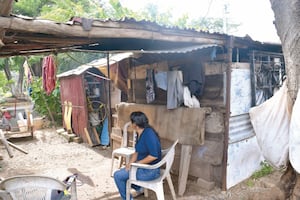Más Información
Mundial 2026 genera riesgo de fraudes y reventa, alerta Concanaco; sugiere desconfiar de enlaces y ofertas en redes sociales

Marco Rubio destaca labor de seguridad de México; "están haciendo más que nunca en su historia", afirma

Inegi oficializa creación de nueva instancia para medir la pobreza, tras desaparición del Coneval; crea una Dirección General

Juez frena revocación de testigo protegido a Raúl Rocha; da medida cautelar a dueño de Miss Universo

Sin garras y con lesiones Profepa rescata a león amarrado a un árbol en Nayarit; inician investigación
Xipe Tótec (Our Flayed Lord)
was one of the most important gods in pre-Hispanic cultures . His influence on fertility, agricultural cycles, and war, was recognized by numerous cultures throughout the Mexican territory. However, a temple associated with said deity had never been found before.
Archaeologists were able to discover two sacrificial altars, three stone sculptures, and several architectural elements located within a pyramidal base in the Ndachjian-Tehuacán archeological area , in the state of Puebla . The pieces have confirmed that the ancient city was home to a temple dedicated to the Xipe Tótec deity, which is the first of its kind ever discovered in the country.
The archeologist Noemí Castillo Tejero, director of the state of Puebla’s central Popoloca research project , said that the association was evident, not only because the sculptures –which represent two skinned skulls and a torso covered in sacrificial skin- clearly represent Xipe Tótec, but also because the building, which was used between 1,000 and 1,260 A.D. , showed features conciding with sacrificial sites described by documentary sources.
The investigator from the National Institute of Anthropology and History (INAH) added that the construction was located west of the Ndachjian complex. The finding was registered after a couple of sculptures portraying the same deity were discovered in front of the temple. Said sculptures are now exhibited at the Tehuacán Museum .
One of the most important festivities in ancient Mexico was the Tlacaxipehualiztli ( Náhuatl for: “To wear the skin of the flayed one”) . It was usually held in two circular altars: The first was for a ritual sacrifice of prisoners through gladiator-like games and executions with arrows; the second was for the skinning of prisoners in honor of Xipe Tótec , a process in which priests would wear the skin of the individuals at hand and later place them in small holes made in esplanades, facing the altars.
This highlights the importance of the archeologists’ work, led by Noemí Castillo. They were able to find both sacrificial altars in the pyramid base, and even two holes in the ground, facing the altars, under the stone skulls.
“This indicates that the skulls were meant to close the holes,” commented the archeologist, adding that the constructions found in Ndachjian had been built in several stages: The first was built between the years 900 and 1,260 A.D. ; the second, which coincides with the city’s upsurge, as well as the other Popolca lordships ( Tecamachalco, Tepeji, and Coixtlahuaca ) was built in the 14th century, and the third, which was left unfinished, was built in the middle of the 15th century.
Archeologists are confident that they will soon find the upper layers of the pyramid, or even the altar from the second stage, to which the two stone skulls corresponded.
dm
Noticias según tus intereses
[Publicidad]
[Publicidad]










